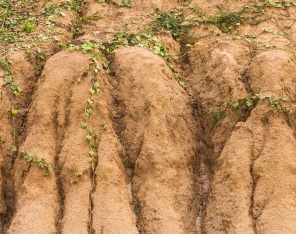
Common Mulches That Are Used For Hydromulching

The core and most important component of any Hydraulic Growth Medium (HGM) is the mulch used to provide protection for seeds, water holding capacity and erosion resistance. This is the bulk of a hydromulch and choosing the right one can help to ensure long term viability of your newly sprayed area. Several different cellulosic mulches are used in the hydromulch industry today, often in conjunction with polymer based binders; each has its own unique properties, benefits and uses.
Paper Pulp
Likely the first type of mulch to be used in the hydromulch industry, paper pulp and cellulose mulch provides good water retention along with smooth and even distribution onto the soil surface. Used along with a binder/tackifier, it can produce reasonable results on flat and barely inclined soils. This method will not, however, produce adequate erosion control on slopes or against moderate weather events until the crop is germinated and established. It can also cause difficulties with seeds being able to penetrate the crust that’s formed once it dries.
Wood Fibre
Wood fibre mulch is derived from hardwood and softwood timber and sometimes from post-consumer wood waste. The best type is heat treated under pressure, which creates long wood fibres with a high water holding capacity, up to 10 times its own weight. Wood fibre mulch can be used on steep slopes and can be used to form a Bonded Fibre Matrix (BFM), providing even greater protection and longevity.
Wood fibres have a carbon to nitrogen ratio (C:N) of 100:1, [AB1] which means that as the mulch breaks down over time due to microbial action, nitrogen is removed from the soil, effectively reducing the nutrition for the plants over time. This can be mitigated by simply adding a slow release or organic source of nitrogen.
Sugar Cane
Sugar cane bagasse is another common choice of mulch, particularly if sugar is a local industry, i.e. Queensland. Similarly to wood, steam or heat treated bagasse is generally superior to non-treated, having greater water retention and fibre properties. Sugar cane mulch can hold up to around seven times its own weight in water and has a reasonable fibre length, again also making it suitable for use in BFMs. The C:N ratio of sugar cane is 80:1[AB1] , meaning it may cause nitrogen draw down in the soil if ameliorants are not used.
Straw Mulch
Heat treated straw mulch is somewhat newer than other types of mulch and has seen an increase in use over the last ten years. Again having long fibres suitable for use in BFMs, straw also has a much more favourable C:N ratio of 35:1. This means it is less likely to cause nitrogen drawdown and less chemical fertilizers are needed. Straw mulch can hold around 5 times its weight in water, however, it can release this moisture somewhat easier than other mulches allowing the water to be better utilised.
Cotton
Cotton hydromulch utilises by-products of the cotton industry to produce a product that can hold its own against the other types of mulch. Considered relatively sustainable, this mulch has been shown in tests conducted by universities in the USA to have a significantly reduced particle run off compared to either straw or wood. As Australia has a cotton industry, this could be another source of sustainable, quality mulch for the industry.
Other Common additives
Each of these hydromulches will generally have an included soil binder/tackifier to greatly enhance the bond between the fibres, which in turn creates a better structure for reducing erosion and protecting the seeds prior to germination. These are most commonly organic or polymer based adhesives, such as PVA, guar gum or polyacrylamide.
Each has a different bond strength and effective lifespan and will breakdown to non-toxic compounds over time. If a Bonded Fibre Matrix is being used, the amount of binder/tackifier is usually higher, along with approximately double the rate of application of long fibre mulch. This makes for much stronger erosion control an enables its use over much steeper inclines. Bitumen emulsion is a less commonly used adjunct to Hydromulching but can be quite effective. It is sprayed after the hydromulch goes down, providing enhanced erosion protection, greater water infiltration and tends to keep temperature more constant. However, needing to be sprayed on after mulching will increase overall costs.
Some products on the market go one step further than simply providing a growth medium along with nutrients. Envirostraw Plus, as one example, includes beneficial microbes, namely bacteria and mycorrhiza fungi. By doing so, a Hydraulic Growth Medium is capable of not only improving the soil structure more quickly but also unlocking nutrients and creating a symbiotic relationship with the target crop, enabling better resilience to stressful conditions. In this way the plants are more closely aligned with nature and a much more sustainable lifecycle is reached.





